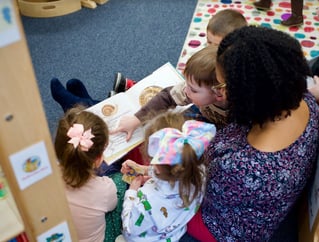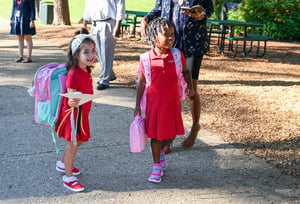by Rebecca Ginnetti, School Counselor


As summer winds down, our community is preparing for the new school year. Faculty and staff are preparing classrooms and finalizing the day to day routines, while families are getting backpacks, footwear, uniforms, and Fall schedules ready. While many children and adults are excited about the start of the school year, preparing for the worries or feelings of anxiety that can accompany this excitement and anticipation about school is important. Here are some suggestions and resources to support your family as you transition from summer break to the new school year.
5 steps for dealing with worries about returning to school
Adapted from Coping with Back to School Anxiety by AnxietyCanada.com
STEP 1 TAKE CARE OF THE BASICS
Get adequate sleep, eat regular meals and healthy snacks and exercise daily. When minds and bodies are nourished, tackling worries is easier. Daily routines at home are comforting for children of all ages when other areas of their lives may be changing. Family fun, time outside away from technology, and talking with friends and family are good ways to build emotional reserves and readiness for the new adventure ahead.
STEP 2 PROVIDE EMPATHY
Listen to your child’s concerns. What are they worried about? What do they expect to happen? Let your child share their worries and talk about what’s on their mind. Initiate conversations when you are in the car, standing in line at the store, at bed-time or dinner. For some kids and teens this “casual” method of talking feels less intense and makes it easier for them to express themselves. For older children who may feel they need to handle worries on their own, drop reminders throughout the day that you are aware of the upcoming changes and are available to listen to understand and help.
STEP 3 PROBLEM SOLVE
When concerns or worries are identified, rather than downplaying those worries and telling children that “it will be okay”, help your child develop a coping plan. Remember to reinforce the strategies they have used in the past and the successes they have had in new situations. Co-creating a plan with concrete solutions, will significantly reduce the worry. For example, “If (the worst) happens, what could you do?” or “Let’s think of some ways you could handle that situation.” This gives you the opportunity to coach your child on how to cope with (and interpret) real and “what if” situations.
STEP 4 FOCUS ON THE POSITIVE ASPECTS
Once you have an understanding of what your child is concerned about, and a coping plan to address their concerns or fears has been created, you can encourage your child to re-direct attention away from the worries towards the positives. Ask your child, “What are three things that you are most excited about on your first day of school?” Promote a growth mindset that includes the benefits of trying something new, making mistakes, and asking for help, to build confidence and resilience.
STEP 5 PAY ATTENTION TO YOUR OWN BEHAVIOR
Parents and caregivers also worry about the start of the school year. Preparation, wanting their child to learn and be happy, and managing a new routine. Remember that children of all ages take cues from their parents and caregivers, the more confidence and calm you can model, the more your child will believe they can handle this new school year. Be supportive yet firm. When saying goodbye in the morning, say it cheerfully – once! Avoid rewarding a child’s protests, crying, or tantrums by allowing them to stay home. Instead, in a calm tone, say: “I can see that going to school is making you scared, but you still have to go. Tell me what you are worried about, so we can talk about it.” Lastly, remember to get your social and emotional needs met from other adults, seek out support and connection.
__________________________________________
For more information regarding preparing for school and managing worry and transitions, please visit the resources below.
Please remember that the teachers, administrators, and staff at Congressional School are here to support your family’s transition and journey through the school year. I invite you to contact me if you have questions or concerns about your child’s social and emotional well-being and growth at Congressional. I am here to support families and children in achieving social and emotional wellness.
Additional Resources:
Preparing for Back-to-School Success
COVID-19 pandemic: Helping young children and parents transition back to school
How to Manage Back-to-School Anxiety in Kids
Resource for teens with anxiety to read:(please review before sharing with your teen)

Rebecca Ginnetti
School Counselor






